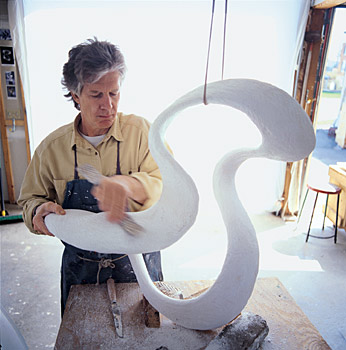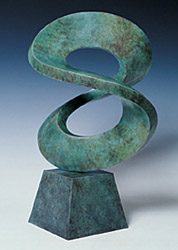 |
||
| uvm a - z | directory | search |
 |
DEPARTMENTS LINKS
|

Carving Artist
The worlds of stone and snow according to Richard Erdman
by Thomas Weaver, photograph by Sabin Gratz
If Richard Erdman’s
steep and sinuous sculptures were ski slopes, they would be black diamonds.
Looking one over, you find yourself wishing you were the size of an
action figure, able to click into a couple of Popsicle sticks, and make
like one of those guys in a Warren Miller movie.
It’s no mystery why Erdman’s art evokes athleticism and the
contours of nature; he was a two-time All-American skier during his
undergraduate years at UVM in the 1970s. And there’s ample evidence
that, at age 51, movement is still one of the great joys of his life.
Clue No. 1 — the pairs of skis leaning at the ready in the corner
of his Williston studio. Clue No. 2, a couple of hours talking with
Erdman, the themes of the conversation bringing to mind the motto of
novelist John Irving’s character Garp — “We must have
energy!”
But even though he juggles the roles of artist and businessman daily,
Erdman’s isn’t a frenetic, multi-tasking sort of energy. It’s
more about a Zen calm, the rare ability to retain perfect focus while
moving swiftly. Making maybe his fifth reference to the connection between
his skiing and his art, Erdman stops himself momentarily. “I hate
to keep doing this,” he says, then, “No, actually, I love
to keep doing this…”
Erdman has learned from many over the course of his successful 28 years
as a professional artist. He credits Vermont professors and Italian
artisans among his influences, but when he considers the mental tenacity
required in his profession, the artist says he often draws from a reservoir
of lessons from the sporting life. Erdman speaks of things like the
importance of knowing oneself well that can only come from testing oneself
well; the ability to dig deep for reserves of strength and confidence
in the face of a challenge; and the desire to continually seek those
challenges.
There’s one more, the interplay between coach and athlete (or patron
and artist) that can make you elevate your game. When Erdman thinks
of those situations, his memories return to working with Chip LaCasse,
the longtime director of skiing who retired from coaching this year.
“It is a matter of one pushing the other in a gentle, spirited,
competitive way, and that goes back to my days with Chip. The man is
kind and gentle, and yet underneath he’s always got a little needle,
saying, ‘I bet you can’t go faster. I bet you can’t do
that.’ He’s a leader who leads by being there with you, but
letting you go.”
NO LOOKING BACK
Erdman acknowledges that it was probably more a sense of Yankee practicality
than a desire to teach that steered him toward art education during
his undergraduate years at UVM. An artist needs a way to pay the bills,
after all.
Erdman still saw teaching in his future when he enrolled in a master’s
program which opened with a semester of study abroad in Italy. Looking
back, Erdman admits that he crossed the Atlantic with a not-so-hidden
agenda, which he put into action with a train ride from Florence to
the fabled marble region of Carrara. It was no accident that he packed
his sculpting tools for the trip. Connecting quickly with the skilled
artisans of the region, Erdman found what he’d truly traveled to
Italy to learn. “There was no looking back,” he recalls. “I
knew that this was my calling, I just didn’t know how I was going
to get there.”
He started with six weeks apprenticing to a Carrara stone carver. When
his lire ran dry, Erdman packed his bags and some crates of the local
marble and returned to Vermont. The late Professor Paul Aschenbach,
both a mentor and friend to Erdman during his undergraduate years, offered
the young artist use of the sculpting studio in the basement of Williams
Hall in exchange for teaching art students stone carving.
Erdman had turned down a chance to join the U.S. Ski Team to pursue
his art, and he attacked the Italian marble with physical vigor and
mental energy that he had previously channeled into competition. No
doubt there is still some Carrara dust drifting around Williams.
There were day jobs to pay the bills early on, but Erdman met with success
remarkably quickly. A key break came when Pepsi CEO Donald Kendall “took
a chance” on Erdman by giving him the commission of a lifetime
when he was barely out of his twenties. The result was “Passage,”
a 45-ton sculpture of Roman travertine marble that sits at the entrance
to the famous sculpture gardens at PepsiCo headquarters in Purchase,
New York. The project was large in so many ways — inspired by the
energy of the Grand Canyon; two years of work; hundreds of thousands
of dollars invested; logistically daunting moves from Rome to Carrara,
Italy to the United States, the docks of Manhattan to Purchase. It arrived
beautiful and intact, and stands in Purchase today, the world’s
largest sculpture created from a single piece of marble.
SHIFTING GEARS
Erdman admits that a certain fear factor drives him on a monster project
like the Pepsi commission. He has dug deep many times throughout a career
in which he has produced more than 400 pieces for collectors, museums,
and gallery exhibitions. His major commissions include a 1999 call from
the EastWest Institute to produce two works, which resulted in “Global,”
a symbolic centerpiece displayed in the New York and Prague headquarters
of the organization dedicated to social and economic development in
Eastern Europe, and “Statesman,” replicas of which have been
presented annually as awards to world leaders such as U.S. President
George W. Bush and Germany’s former chancellor Helmut Kohl.
Erdman’s art is on display from Singapore to Saudi Arabia, but
one of his most notable creations is the life he has carved for himself
right at home. He is an artist who is pleased but not satisfied to complacence
with his work, a successful business man, and, by all appearances, a
happy, balanced guy.
The rambling, old farmhouse where he lives with his wife, Madeleine
Austin Erdman, is just a walk across the yard from their working lives
— Madeleine’s Imajica Horse Farm (home of the UVM Equestrian
Club she coaches) and Erdman’s airy studio. Italian opera turned
up on the stereo, big windows opening on views of horses strolling in
the pasture, Richard Erdman goes about his business in the studio, while
Madeleine goes about her work at the farm. Both absorbed in their pursuits,
often they won’t cross paths until dinner.
“I believe in movement, that’s what life is all about,”
Erdman says, as he tries to put his creative process into words. “I
like to work quickly; I love having a mess when I create. Something
will tumble on the floor and I’ll see a shape or an idea that inspires
me and I’ll pick it up. You have to allow chance.” He pauses
then concludes, “I feel lucky and even a bit self-conscious about
feeling like a kid in the sand box at my age.”
Erdman is often in the thick of studio work when the phone will ring,
and he switches gears effortlessly. It may be a gallery owner negotiating
a sale or a call about a potential commission. Where many talented artists
may fall short for lack of the patience, organization, or skill to handle
such matters, this is another place where Erdman excels. He prides himself
on this ability to wash his hands and morph from artist to businessman
in the space of a few minutes.
It’s all about discipline, Erdman says, and he calls it his most
important tool as an artist. Your guess where he first learned it.

Going
Once
Richard Erdman ’75 has given tribute to his former ski coach Chip
LaCasse by donating to the University a one of one bronze casting of
his work “Global.” The piece will be auctioned on Friday,
October 3, during UVM’s Homecoming Weekend. Reserve bid is $15,000
and all proceeds will support the Chip LaCasse Ski Endowment. For more
information on Erdman’s art see www.richard erdman.com. Details
on the auction: www.uvm. edu/alumni. And to view the sculpture, visit
the Fleming Museum, where it will be on display beginning August 1.
